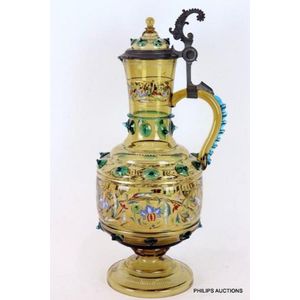Bavarian Pewter-Mounted Glass Pitcher with Enamel and Prunts
A Bavarian pewter-mounted painted glass pitcher, probably Theresienthal, Bavaria, circa 1890 the large beer stein jug or pitcher, in yellowish green amber tone, the pewter lid with glass insert, the c-shaped handle with applied crimped blue glass trail, the body and neck enameled with gold lined bands of flower heads and scrolling foliage, between borders of applied green glass prunts, all raised on a broad conical base with gilt and beaded borders. Height 43.5 cm
You must be a subscriber, and be logged in to view price and dealer details.
Subscribe Now to view actual auction price for this item
When you subscribe, you have the option of setting the currency in which to display prices to $Au, $US, $NZ or Stg.
This item has been sold, and the description, image and price are for reference purposes only.
- Circa - A Latin term meaning 'about', often used in the antique trade to give an approximate date for the piece, usually considered to be five years on either side of the circa year. Thus, circa 1900 means the piece was made about 1900, probably between 1895 and 1905. The expression is sometimes abbreviated to c.1900.
- Crimped - A wavy effect on the the rims or lips of glass or silver vessels. Crimping was frequently used on brightly coloured Victorian glass.
- Ewer / Pitcher - A type of jug with a narrow neck bulbous body and wide spout, originally used for carrying and storing liquids such as water or wine. In medieval times they were the source of water to wash ones hands during and after a meal. later the shape was used for vessels in silver, gold, glass and ceramics.
In Victorian times they were made in ceramics and occasionally glass with a matching basin, and sometimes other accessories such as a soap holder or toothbrush holder. Their purpose was to provide facilities for personal washing In the early 19th century were often enclosed in purpose built stands, and later resided on a washstand..
Sometimes the words "ewer" and "pitcher" are used interchangably, but a pitcher is generally considered to be a jug, and would have a wide mouth, and a gently tapering body.
This item has been included into following indexes:
